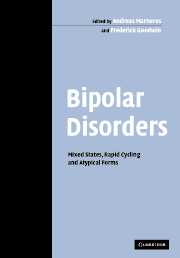Book contents
- Frontmatter
- Contents
- List of contributors
- Preface
- 1 Bipolar disorders beyond major depression and euphoric mania
- 2 Emerging concepts of mixed states: a longitudinal perspective
- 3 Rapid-cycling bipolar disorder
- 4 Bipolar I and bipolar II: a dichotomy?
- 5 Recurrent brief depression as an indicator of severe mood disorders
- 6 Atypical depression and its relation to bipolar spectrum
- 7 Agitated depression: spontaneous and induced
- 8 Schizoaffective mixed states
- 9 Acute and transient psychotic disorder: an atypical bipolar disorder?
- 10 Bipolar disorder in children and adolescents
- 11 Atypical features of bipolarity in old age
- 12 Comorbidity in mixed states and rapid-cycling forms of bipolar disorders
- 13 Challenges in the genetics of bipolar disorder
- 14 Biological aspects of rapid-cycling and mixed states
- 15 The treatment of bipolar mixed states
- 16 The use of atypical antipsychotic agents in the treatment of diagnostic subgroups of bipolar disorder: mixed and pure states, psychotic and non-psychotic
- 17 Investigational strategies: treatment of rapid cycling, mixed episodes, and atypical bipolar mood disorder
- Index
- References
13 - Challenges in the genetics of bipolar disorder
Published online by Cambridge University Press: 10 August 2009
- Frontmatter
- Contents
- List of contributors
- Preface
- 1 Bipolar disorders beyond major depression and euphoric mania
- 2 Emerging concepts of mixed states: a longitudinal perspective
- 3 Rapid-cycling bipolar disorder
- 4 Bipolar I and bipolar II: a dichotomy?
- 5 Recurrent brief depression as an indicator of severe mood disorders
- 6 Atypical depression and its relation to bipolar spectrum
- 7 Agitated depression: spontaneous and induced
- 8 Schizoaffective mixed states
- 9 Acute and transient psychotic disorder: an atypical bipolar disorder?
- 10 Bipolar disorder in children and adolescents
- 11 Atypical features of bipolarity in old age
- 12 Comorbidity in mixed states and rapid-cycling forms of bipolar disorders
- 13 Challenges in the genetics of bipolar disorder
- 14 Biological aspects of rapid-cycling and mixed states
- 15 The treatment of bipolar mixed states
- 16 The use of atypical antipsychotic agents in the treatment of diagnostic subgroups of bipolar disorder: mixed and pure states, psychotic and non-psychotic
- 17 Investigational strategies: treatment of rapid cycling, mixed episodes, and atypical bipolar mood disorder
- Index
- References
Summary
Epidemiology of mood disorders
Major depressive disorder (MDD) is the leading cause of disability among those age 5 and over, and the second leading source of disease burden, surpassing cardiovascular diseases, dementia, lung cancer, and diabetes (Murray and Lopez, 1996). The dramatic impact of mood disorders on distress to the affected individual and his or her family, lifetime disability, and suicide highlights the importance of etiologic research to inform treatment and prevention.
Community-based rates of mood disorder are essential to deriving estimates of population familial recurrence risk (λ) (Risch, 1990). Population prevalence estimates of mood disorders are available from two community surveys of the USA: the Epidemiologic Catchment Area (ECA) study of five sites in the USA (Robins and Regier, 1991), and the National Comorbidity Survey (NCS) of a probability sample of the USA conducted 10 years later (Kessler et al., 1994). Estimates of base rates of bipolar disorder (or manic episodes) were very low in both studies, averaging 0.8% in ECA and 1.6% in NCS. In contrast, there is a very high lifetime prevalence of MDD in the US population (females, 12% ECA; 21.3% NCS, and males, 5% ECA, 12.7% NCS). Similar base rates of mood disorders have been obtained in international studies as well (Weissman et al., 1996). With respect to demographic factors, the differences between the bipolar and major depression subtypes of mood disorders include the sex ratio that favors women for MDD but is nearly equal for men and women for bipolar disorder, and the age of onset that occurs nearly a decade earlier in MDD than in bipolar disorder (Weissman et al., 1991).
Keywords
- Type
- Chapter
- Information
- Bipolar DisordersMixed States, Rapid Cycling and Atypical Forms, pp. 277 - 310Publisher: Cambridge University PressPrint publication year: 2005

